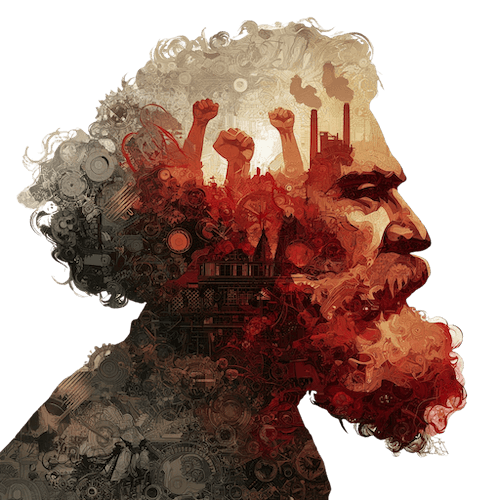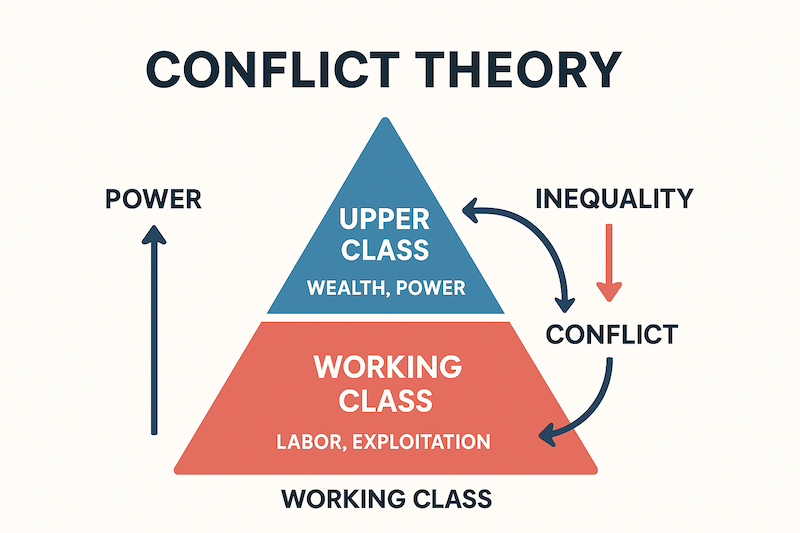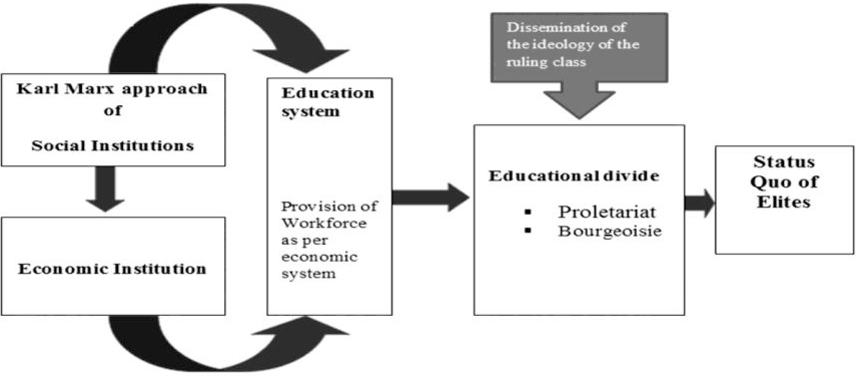Conflict Theory
Explore conflict theory and how power struggles, inequality, and social tensions drive change and shape modern societies.


Conflict theory is a powerful sociological framework that examines society through the lens of competition, inequality, and power struggles. As of 2025, this theory remains incredibly relevant, helping explain contemporary societal issues ranging from economic disparity to systemic injustice. At its heart, conflict theory proposes that society is inherently composed of groups with differing and competing interests, often driven by inequalities in wealth, power, and social prestige.
The core idea is straightforward: those who control society's valuable resources use their power to preserve their privileges. Meanwhile, individuals and groups with fewer resources continuously push against this established order, seeking fairer access and more equitable outcomes. This ongoing tension, known as class struggle, is viewed as essential for sparking meaningful societal transformations and reforms.
To summarise the key ideas of Conflict Theory clearly:
Next, we'll examine the principles and implications of conflict theory, exploring how this sociological lens enhances our understanding of modern societal challenges.
Conflict theory didn't emerge overnight. Instead, it evolved through the work of influential conflict theorists who sought to explain why societies are often defined by tension, struggle, and deep divisions. From the industrial upheavals of the 19th century to today's global debates around inequality and identity, this framework has continued to adapt, intersecting with concepts like postcolonial theory and postmodern theory.
Karl Marx, a German philosopher and revolutionary thinker, is widely regarded as the founder of classical conflict theory. Writing during the rise of industrial capitalism, Marx argued that social stratification, the division of society into hierarchical classes, was an inevitable feature of capitalism itself.
Class Conflict and Economic Inequality
Marx believed all history could be understood as the history of class struggle. According to his theory:
This economic imbalance created an inherent conflict. The bourgeoisie sought to maximise profit, often at the expense of workers' rights and well-being. For Marx, the only path toward genuine conflict resolution was revolution: overthrowing the capitalist system to establish a classless society.

While Marx focused on material resources, Max Weber introduced a broader perspective. He argued that social stratification was shaped by more than just economics. Instead, power could stem from multiple sources: social prestige, cultural norms, and institutional authority.
Beyond Economics: Power and Identity
Weber emphasised that:
This approach laid the groundwork for later theories that explore how power operates in cultural and symbolic realms, anticipating elements of postmodern theory and postcolonial theory.

Beyond Marx and Weber, several other thinkers expanded the field, applying conflict theory to new contexts.
W.E.B. Du Bois
Du Bois examined how racial conflict shaped the social order in America, highlighting the enduring impact of systemic racism and the colour line.
C. Wright Mills
Mills introduced the concept of the "power elite," arguing that small networks of political, military, and economic leaders shape society's direction, often beyond democratic control.
Antonio Gramsci
Gramsci developed the notion of cultural hegemony, explaining how dominant groups maintain power by shaping ideology, values, and everyday beliefs.

In the 20th and 21st centuries, conflict theory has evolved further, integrating new ideas.
Summary of Key Ideas
Here's a concise overview of what you've just explored:

Conflict Theory is a sociological perspective that examines society through the lens of competition and inequality among different social groups. According to Conflict Theory, social structures are shaped by the power dynamics and conflicts that arise from the unequal distribution of resources and social status within society.
In this view, society isn't harmonious but rather characterised by struggle and conflict. Different groups compete for limited resources, privileges, and opportunities, leading to the creation and maintenance of social inequalities. These inequalities aren't accidental but are instead an inherent feature of social structures.
Conflict arises from the unequal distribution of power, resources, and social status. Those in positions of power use their influence to maintain their advantage, while those with less power and resources struggle to gain access to these limited opportunities. These power dynamics create a system in which the dominant groups further exploit and oppress the marginalised groups.
Conflict Theory challenges the status quo by highlighting these power imbalances and advocating for social change. It emphasises that societal progress and transformation occur through the resolution of these conflicts, as marginalised groups strive for equity and justice.
By examining social structures from a Conflict Theory perspective, we gain insight into the mechanisms that perpetuate inequality and the pathways for creating a more just and equitable society.

Conflict theory identifies several key causes of conflict within society. Firstly, social structures and institutions play a significant role in the perpetuation of conflict.
These structures, such as economic and political institutions, create and maintain social inequalities, leading to competition for limited resources and privileges. Secondly, power dynamics contribute to conflict, as those in positions of power use their influence to retain their advantage while suppressing the marginalised groups.
The struggle for power and access to resources often results in conflict. Another cause of conflict is the class struggle within capitalist societies. Conflict theorists argue that capitalist societies inherently create and perpetuate social inequalities, leading to class conflict between the dominant class and the marginalised working class.
Additionally, social inequality and injustices can further fuel conflict as marginalised groups seek to challenge and change the status quo. Conflict theorists identify various causes of conflict, including social structures, power dynamics, class struggle, and social inequality, all of which contribute to ongoing conflicts within societies.
Conflict theory underscores the pivotal role of social structures and institutions in perpetuating conflict. Economic and political institutions, in particular, are instrumental in creating and sustaining social inequalities.
This leads to a fierce competition for limited resources and privileges, with those in positions of power leveraging their influence to maintain their advantageous position, while suppressing marginalised groups. The struggle for power and access to resources becomes a breeding ground for conflict.

The theory posits that capitalist societies inherently give rise to social inequalities, resulting in a class struggle between the dominant class and the marginalised working class.
This struggle is fuelled by the unequal distribution of resources and opportunities, leading to social divisions and ongoing conflict. Social inequalities and injustices further intensify this conflict, as marginalised groups strive to challenge and alter the status quo.
Conflict theory examines the concept of role differentiation, highlighting how the division of labour and allocation of varied roles within social structures lead to power imbalances and conflicts.
Individuals are assigned different roles based on their skills, qualifications, and positions, resulting in varying levels of authority and access to resources. This unequal distribution of power sets the stage for conflicts, as individuals vie for resources and influence.

The theory also explores the relationship between conflict and individualism, emphasising how societal conflicts arise from the power struggle between individuals and groups with conflicting interests.
Individualism, with its focus on personal freedom and self-interest, contributes to this competitive environment, intensifying conflicts and perpetuating social inequality.
Conflict theory sheds light on the concept of incompatible roles, illustrating how conflicting expectations within social structures can lead to tensions and conflicts. Whether in the workplace or on a societal level, these incompatible roles highlight the power dynamics and inequalities that pervade society, contributing to ongoing conflicts and class struggles.
The struggle for access to limited resources, termed as contested resources in conflict theory, results in competition and conflict among different social groups and classes. This struggle is a direct consequence of social structures and institutions that perpetuate inequality, leading to class conflict and the maintenance of the status quo.
By dissecting these causes of conflict, conflict theory provides a comprehensive understanding of the power dynamics, social inequalities, and struggles that characterise society. It offers a lens through which to examine and address the root causes of conflict, paving the way for a more equitable and just society.

Modern day examples of conflict theory can be seen in various social issues that affect our society.
By examining these modern examples, conflict theory's relevance in understanding and addressing contemporary social issues becomes clear, offering pathways for societal reflection and potential transformation.

While conflict theory provides valuable insights into power dynamics and social inequality, it isn't without its critiques and limitations.
One critique is that conflict theory often neglects the importance of cooperation and consensus in social relations. While conflicts and power struggles do exist, social interactions aren't solely driven by competition for resources. Cooperation and consensus play significant roles in shaping social relationships and maintaining stability within societies, yet these aspects are often overlooked or oversimplified in conflict theory.
Another criticism is that conflict theory can sometimes oversimplify the diverse experiences within social groups. It tends to view social groups as homogeneous entities, overlooking the internal dynamics and complexities that exist within them. This oversimplification can limit our understanding of the multitude of factors that contribute to social inequalities and can hinder efforts to address these issues effectively.
Furthermore, conflict theory has been criticised for its politicisation, particularly due to its association with Karl Marx and its widespread use in various causes and movements. Some argue that this politicisation can hinder objective analysis and understanding, as conflict theory is sometimes used as a tool to further specific ideological agendas rather than providing a nuanced understanding of social dynamics.
In light of these critiques, it's important to recognise that conflict theory offers valuable insights but should be complemented by other perspectives to provide a more comprehensive understanding of social phenomena.
By incorporating alternative perspectives such as functionalism, which emphasises the balance created by different social institutions and the inevitability and usefulness of inequality in society, a more nuanced and holistic understanding can be achieved.

How might conflict theory be conceptually linked to the following?

Addressing social inequalities requires a multifaceted approach that incorporates various strategies to promote social justice. By understanding and analysing these inequalities through different sociological paradigms, it becomes possible to develop effective strategies to address them.

These studies provide a diverse range of perspectives on conflict theory, its applications, and its implications for understanding social dynamics.
Realistic Group Conflict Theory: A Review and Evaluation of the Theoretical and Empirical Literature (Jackson, 1993)
This paper provides a comprehensive review and evaluation of Realistic Group Conflict Theory, highlighting its potential to offer valuable insights for contemporary social scientists. The theory is praised for its ability to fulfil theoretical functions and its scientific rigour.
Is Conflict Adaptation an Illusion? (Schmidt, Notebaert & Van den Bussche, 2015)
This research raises questions about the validity of conflict adaptation theory, presenting diverse perspectives and encouraging further research for more definitive answers.
The Psychology of Intergroup Conflict: A Review of Theories and Measures (Böhm, Rusch & Baron, 2018)
This paper reviews various theories and measures related to the psychology of intergroup conflict, suggesting that an interdisciplinary approach could enhance future research in this field.
Boundary Critique and Its Implications for Conflict Prevention (Midgley & Pinzón, 2011)
This study explores the theory of boundary critique and its utility in conflict prevention, emphasising the importance of dialogue and fair decision-making processes.
Conceptions of Conflict in Organizational Conflict Research: Toward Critical Reflexivity (Mikkelsen & Clegg, 2019)
This essay encourages a critical examination of the philosophical and political assumptions about conflict in organisational conflict research, proposing theoretical linkages and a future research agenda.
Conflict theory is a powerful sociological framework that examines society through the lens of competition, inequality, and power struggles. As of 2025, this theory remains incredibly relevant, helping explain contemporary societal issues ranging from economic disparity to systemic injustice. At its heart, conflict theory proposes that society is inherently composed of groups with differing and competing interests, often driven by inequalities in wealth, power, and social prestige.
The core idea is straightforward: those who control society's valuable resources use their power to preserve their privileges. Meanwhile, individuals and groups with fewer resources continuously push against this established order, seeking fairer access and more equitable outcomes. This ongoing tension, known as class struggle, is viewed as essential for sparking meaningful societal transformations and reforms.
To summarise the key ideas of Conflict Theory clearly:
Next, we'll examine the principles and implications of conflict theory, exploring how this sociological lens enhances our understanding of modern societal challenges.
Conflict theory didn't emerge overnight. Instead, it evolved through the work of influential conflict theorists who sought to explain why societies are often defined by tension, struggle, and deep divisions. From the industrial upheavals of the 19th century to today's global debates around inequality and identity, this framework has continued to adapt, intersecting with concepts like postcolonial theory and postmodern theory.
Karl Marx, a German philosopher and revolutionary thinker, is widely regarded as the founder of classical conflict theory. Writing during the rise of industrial capitalism, Marx argued that social stratification, the division of society into hierarchical classes, was an inevitable feature of capitalism itself.
Class Conflict and Economic Inequality
Marx believed all history could be understood as the history of class struggle. According to his theory:
This economic imbalance created an inherent conflict. The bourgeoisie sought to maximise profit, often at the expense of workers' rights and well-being. For Marx, the only path toward genuine conflict resolution was revolution: overthrowing the capitalist system to establish a classless society.

While Marx focused on material resources, Max Weber introduced a broader perspective. He argued that social stratification was shaped by more than just economics. Instead, power could stem from multiple sources: social prestige, cultural norms, and institutional authority.
Beyond Economics: Power and Identity
Weber emphasised that:
This approach laid the groundwork for later theories that explore how power operates in cultural and symbolic realms, anticipating elements of postmodern theory and postcolonial theory.

Beyond Marx and Weber, several other thinkers expanded the field, applying conflict theory to new contexts.
W.E.B. Du Bois
Du Bois examined how racial conflict shaped the social order in America, highlighting the enduring impact of systemic racism and the colour line.
C. Wright Mills
Mills introduced the concept of the "power elite," arguing that small networks of political, military, and economic leaders shape society's direction, often beyond democratic control.
Antonio Gramsci
Gramsci developed the notion of cultural hegemony, explaining how dominant groups maintain power by shaping ideology, values, and everyday beliefs.

In the 20th and 21st centuries, conflict theory has evolved further, integrating new ideas.
Summary of Key Ideas
Here's a concise overview of what you've just explored:

Conflict Theory is a sociological perspective that examines society through the lens of competition and inequality among different social groups. According to Conflict Theory, social structures are shaped by the power dynamics and conflicts that arise from the unequal distribution of resources and social status within society.
In this view, society isn't harmonious but rather characterised by struggle and conflict. Different groups compete for limited resources, privileges, and opportunities, leading to the creation and maintenance of social inequalities. These inequalities aren't accidental but are instead an inherent feature of social structures.
Conflict arises from the unequal distribution of power, resources, and social status. Those in positions of power use their influence to maintain their advantage, while those with less power and resources struggle to gain access to these limited opportunities. These power dynamics create a system in which the dominant groups further exploit and oppress the marginalised groups.
Conflict Theory challenges the status quo by highlighting these power imbalances and advocating for social change. It emphasises that societal progress and transformation occur through the resolution of these conflicts, as marginalised groups strive for equity and justice.
By examining social structures from a Conflict Theory perspective, we gain insight into the mechanisms that perpetuate inequality and the pathways for creating a more just and equitable society.

Conflict theory identifies several key causes of conflict within society. Firstly, social structures and institutions play a significant role in the perpetuation of conflict.
These structures, such as economic and political institutions, create and maintain social inequalities, leading to competition for limited resources and privileges. Secondly, power dynamics contribute to conflict, as those in positions of power use their influence to retain their advantage while suppressing the marginalised groups.
The struggle for power and access to resources often results in conflict. Another cause of conflict is the class struggle within capitalist societies. Conflict theorists argue that capitalist societies inherently create and perpetuate social inequalities, leading to class conflict between the dominant class and the marginalised working class.
Additionally, social inequality and injustices can further fuel conflict as marginalised groups seek to challenge and change the status quo. Conflict theorists identify various causes of conflict, including social structures, power dynamics, class struggle, and social inequality, all of which contribute to ongoing conflicts within societies.
Conflict theory underscores the pivotal role of social structures and institutions in perpetuating conflict. Economic and political institutions, in particular, are instrumental in creating and sustaining social inequalities.
This leads to a fierce competition for limited resources and privileges, with those in positions of power leveraging their influence to maintain their advantageous position, while suppressing marginalised groups. The struggle for power and access to resources becomes a breeding ground for conflict.

The theory posits that capitalist societies inherently give rise to social inequalities, resulting in a class struggle between the dominant class and the marginalised working class.
This struggle is fuelled by the unequal distribution of resources and opportunities, leading to social divisions and ongoing conflict. Social inequalities and injustices further intensify this conflict, as marginalised groups strive to challenge and alter the status quo.
Conflict theory examines the concept of role differentiation, highlighting how the division of labour and allocation of varied roles within social structures lead to power imbalances and conflicts.
Individuals are assigned different roles based on their skills, qualifications, and positions, resulting in varying levels of authority and access to resources. This unequal distribution of power sets the stage for conflicts, as individuals vie for resources and influence.

The theory also explores the relationship between conflict and individualism, emphasising how societal conflicts arise from the power struggle between individuals and groups with conflicting interests.
Individualism, with its focus on personal freedom and self-interest, contributes to this competitive environment, intensifying conflicts and perpetuating social inequality.
Conflict theory sheds light on the concept of incompatible roles, illustrating how conflicting expectations within social structures can lead to tensions and conflicts. Whether in the workplace or on a societal level, these incompatible roles highlight the power dynamics and inequalities that pervade society, contributing to ongoing conflicts and class struggles.
The struggle for access to limited resources, termed as contested resources in conflict theory, results in competition and conflict among different social groups and classes. This struggle is a direct consequence of social structures and institutions that perpetuate inequality, leading to class conflict and the maintenance of the status quo.
By dissecting these causes of conflict, conflict theory provides a comprehensive understanding of the power dynamics, social inequalities, and struggles that characterise society. It offers a lens through which to examine and address the root causes of conflict, paving the way for a more equitable and just society.

Modern day examples of conflict theory can be seen in various social issues that affect our society.
By examining these modern examples, conflict theory's relevance in understanding and addressing contemporary social issues becomes clear, offering pathways for societal reflection and potential transformation.

While conflict theory provides valuable insights into power dynamics and social inequality, it isn't without its critiques and limitations.
One critique is that conflict theory often neglects the importance of cooperation and consensus in social relations. While conflicts and power struggles do exist, social interactions aren't solely driven by competition for resources. Cooperation and consensus play significant roles in shaping social relationships and maintaining stability within societies, yet these aspects are often overlooked or oversimplified in conflict theory.
Another criticism is that conflict theory can sometimes oversimplify the diverse experiences within social groups. It tends to view social groups as homogeneous entities, overlooking the internal dynamics and complexities that exist within them. This oversimplification can limit our understanding of the multitude of factors that contribute to social inequalities and can hinder efforts to address these issues effectively.
Furthermore, conflict theory has been criticised for its politicisation, particularly due to its association with Karl Marx and its widespread use in various causes and movements. Some argue that this politicisation can hinder objective analysis and understanding, as conflict theory is sometimes used as a tool to further specific ideological agendas rather than providing a nuanced understanding of social dynamics.
In light of these critiques, it's important to recognise that conflict theory offers valuable insights but should be complemented by other perspectives to provide a more comprehensive understanding of social phenomena.
By incorporating alternative perspectives such as functionalism, which emphasises the balance created by different social institutions and the inevitability and usefulness of inequality in society, a more nuanced and holistic understanding can be achieved.

How might conflict theory be conceptually linked to the following?

Addressing social inequalities requires a multifaceted approach that incorporates various strategies to promote social justice. By understanding and analysing these inequalities through different sociological paradigms, it becomes possible to develop effective strategies to address them.

These studies provide a diverse range of perspectives on conflict theory, its applications, and its implications for understanding social dynamics.
Realistic Group Conflict Theory: A Review and Evaluation of the Theoretical and Empirical Literature (Jackson, 1993)
This paper provides a comprehensive review and evaluation of Realistic Group Conflict Theory, highlighting its potential to offer valuable insights for contemporary social scientists. The theory is praised for its ability to fulfil theoretical functions and its scientific rigour.
Is Conflict Adaptation an Illusion? (Schmidt, Notebaert & Van den Bussche, 2015)
This research raises questions about the validity of conflict adaptation theory, presenting diverse perspectives and encouraging further research for more definitive answers.
The Psychology of Intergroup Conflict: A Review of Theories and Measures (Böhm, Rusch & Baron, 2018)
This paper reviews various theories and measures related to the psychology of intergroup conflict, suggesting that an interdisciplinary approach could enhance future research in this field.
Boundary Critique and Its Implications for Conflict Prevention (Midgley & Pinzón, 2011)
This study explores the theory of boundary critique and its utility in conflict prevention, emphasising the importance of dialogue and fair decision-making processes.
Conceptions of Conflict in Organizational Conflict Research: Toward Critical Reflexivity (Mikkelsen & Clegg, 2019)
This essay encourages a critical examination of the philosophical and political assumptions about conflict in organisational conflict research, proposing theoretical linkages and a future research agenda.